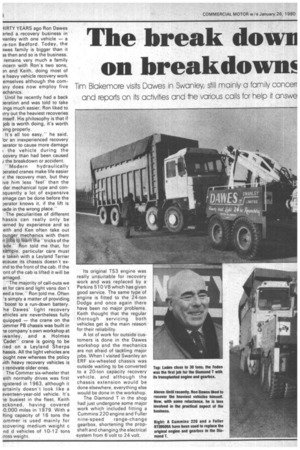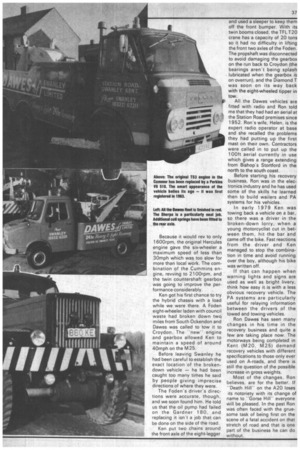The break down on breakdowm
Page 38

Page 39

If you've noticed an error in this article please click here to report it so we can fix it.
Tim Blakemore visits Dawes in SwaHey, still mainly a family concerr and report on its activities and the various calls for helo ft answe
-IIRTY YEARS ago Ron Dawes arted a recovery business in vanley with one vehicle — a ,re-ton Bedford. Today, the awes family is bigger than it as then and so is the business. remains very much a family incern with Ron's two sons, 3n and Keith, doing most of e heavy vehicle recovery work emselves although the cornlny does now employ five echanics.
Until he recently had a back 3eration and was told to take ings much easier, Ron liked to irry out the heaviest recoveries mself. His philosophy is that if job is worth doing, it's worth )ing properly.
It's all too easy," he said, or an inexperienced recovery )erator to cause more damage the vehicle during the ,covery than had been caused the breakdown or accident.
'Modern hydraulically 3erated cranes make life easier ir the recovery man, but they ive him less 'feel' than the der mechanical type and con3quently a lot of expensive 3mage can be done before the Derator knows it, if the lift is lade in the wrong place."
The peculiarities of different hassis can really only be :arned by experienceand so eith and Ken often take out ounger mechanics with them n jAs toflea r'n the ''tricks of the 'acle.Ron told me that, for )(ample, particular care must e taken with a Leyland Terrier ecause its chassis doesn't ex3nd to the front of the cab. If the ont of the cab is lifted it will be amaged.
"The majority of call-outs we et for cars and light vans don't eed a tow," Ron told me. Often 's simply a matter of providing boost to a run-down battery. he Dawes' light recovery chides are nevertheless fully quipped — the crane on the :ommer PB chassis was built in le company's own workshop at ;wanley, and a Holmes 'Cadet" crane is going to be ried on a Leyland Sherpa hassis. All the tight vehicles are ought new whereas the policy iith heavy recovery vehicles is 3 renovate older ones, The Commer six-wheeler that eith normally drives was first 3gistered in 1963, although it ertainly doesn't look like a aventeen-year-old vehicle. It's. le busiest in the fleet, Keith ackoned, having covered 0,000 miles in 1979. With a fting capacity of 16 tons the ,ommer is used mainly for covering medium weight c nd d vehicles of 10-12 tons ross weight. Its original TS3 engine was really unsuitable for recovery work and was replaced by a' Perkins 510 V8 which has given good service. The same type of engine is fitted to the 24-ton Dodge and once again there have been no major problems. Keith thought that the regular thorough servicing both vehicles get is the main reason for their reliability.
A lot of work for outside customers is done in the Dawes workshop and the mechanics are not afraid of tackling major jobs. When I visited Swanley an ERF six-wheeled chassis was outside waiting to be converted to a 20-ton capacity recovery vehicle, and although the chassis extension would be done elsewhere, everything else would be done in the workshop.
The Diamond T in the shop had just undergone some major work which included fitting a Cummins 220 engine and Fuller nine-speed range-change gearbox, shortening the propshaft and changing the electrical 'system from 6' volt to 24 volt. Because it would rev to only 1 600rpm, the original Hercules engine gave the six-wheeler a maximum speed of less than .30mph which was too slow for more than local work. The combination of the Cummins engine, revving to 2100rpm, and the twin countershaft gearbox was going to improve the performance considerably.
Ken got his first chance to try the hybrid chassis with a load while we were there. A Foden eight-wheeler laden with council waste had broken down two, miles from South Ockendon and Dawes was called to tow it to Croydon. The -newengine and gearbox allowed Ken to maintain a speed of around 40mph on the M25.
Before leaving Swanley he had been careful to establish the exact location of the brokendown vehicle — he had been caught too many times he said by people giving imprecise directions of where they were.
The Foden's driver's directions were accurate, though, and we soon found him. He told us that the oil pump had failed on the Gardner 180, and replacing it isn't a job that can be done on the side of the road.
Ken put two chains around the front axle of the eight-legger and used a sleeper to keep them off the front bumper. With its twin booms closed, the TFL T20 crane has a capacity of 20 tons so it had no difficulty in lifting the front two axles of the Foden. The propshaft was disconnected to avoid damaging the gearbox on the run back to Croydon (the bearings aren't being splash lubricated when the gearbox is on overrun), and the Diamond T was soon on its way back with the eight-wheeled tipper in tow.
All the Dawes vehicles are fitted with radio and Ron told me that they had had an aerial at the Station Road premises since 1952. Ron's wife, Helen, is the expert radio operator at base and she recalled the problems they had putting up the first mast on their own. Contractors were called in to put up the 100ft aerial currently in use which gives a range extending from Bishop's Stortford in the north to the south coast.
Before starting his recovery business, Ron was in the electronics industry and he has used some of the skills he learned then to build wailers and PA systems for his vehicles.
In early 1979 Ken was towing back a vehicle on a bar, so there was a driver in the broken-down lorry, when a young motorcyclist cut in between them, hit the bar and came off the bike. Fast reactions from the driver and Ken managed to stop the combination in time and avoid running over the boy, although his bike was written off.
If that can happen when warning lights and signs are used as well as bright livery, think how easy it is with a less obvious recovery vehicle. The PA systems are particularly useful for relaying information between the drivers of the towed and towing vehicles.
Ron Dawes has seen many changes in his time in the recovery business and quite a few are taking place now. The motorways being completed in Kent (M20, M25) demand recovery vehicles with different specifications to those only ever used on A-roads, and there is still the question of the possible increase in gross weights.
Most of the changes, Ron believes, are for the better. If "Death Hillon the A20 loses its notoriety with its change of name to -Gorse Hill" everyone Will be pleased. In the past Ron was often faced with the gruesome task of being first on the scene of a fatal accident on that stretch of road and that is one part of the business he can do without.












































































































































